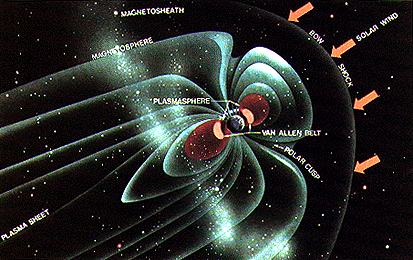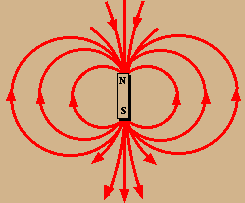
|
||||||||||||||||||||||||
|
Will Compasses Point South? Source: The International Herald Tribune, 15 July 2004, By William J. Broad, NYT
Earths Magnetosphere NASA Graphic The collapse of the earth's magnetic field, which both guards the planet and guides many of its creatures, appears to have started in earnest about 150 years ago. The field's strength has waned 10 percent to 15 percent so far and this deterioration has accelerated of late, increasing debate over whether it portends a reversal of the lines of magnetic force that normally envelop the earth.
In the simplest terms, Earth can be thought of as a dipole (2-pole) magnet. Magnetic field lines radiate between Earth's north and south magnetic poles just as they do between the poles of a bar magnet. Charged particles become trapped on these field lines (just as the iron filings are trapped), forming the magnetosphere. Source NASA During a reversal, the main field weakens, almost vanishes, and then reappears with opposite polarity. Afterward, compass needles that normally point north would point south, and during the thousands of years of transition much in the heavens and earth would go askew. . A reversal could knock out power grids, hurt astronauts and satellites, widen atmospheric ozone holes, send polar auroras flashing to the equator and confuse birds, fish and migratory animals that rely on the steadiness of the magnetic field as a navigation aid. But experts said the repercussions would fall short of catastrophic, despite a few proclamations of doom and sketchy evidence of past links between field reversals and species extinctions. Although a total flip may be hundreds or thousands of years away, the rapid decline in magnetic strength is already damaging satellites. Last month, the European Space Agency approved the world's largest effort at tracking the field's shifts. A trio of new satellites, called Swarm, are to monitor the collapsing field with far greater precision than before and help scientists forecast its prospective state. "We want to get some idea of how this would evolve in the near future, just like people trying to predict the weather," said Gauthier Hulot, a French geophysicist working on the satellite plan. "I'm personally quite convinced we should be able to work out the first predictions by the end of the mission." . The discipline is one of a number - like high-energy physics and aspects of space science - where Europeans have come from behind to seize the initiative, dismaying some American experts. No matter what the new findings, the public has no reason to panic, scientists say. Even if a flip is imminent, it might take 2,000 years to mature. The last one took place 780,000 years ago, when Homo erectus was still learning how to make stone tools. Some experts suggest a reversal is overdue. "The fact that it's dropping so rapidly gives you pause," said John Tarduno, a professor of geophysics at the University of Rochester. "It looks like things we see in computer models of a reversal." In an interview, Tarduno put the odds of an impending flip at more likely than not, adding that some of his colleagues were placing informal bets on the possibility but realized they would probably be long gone by the time the picture clarified. Deep inside the earth, the magnetic field arises as the fluid core oozes with hot currents of molten iron and this mechanical energy gets converted into electromagnetism. It is known as the geodynamo. In a car's generator, the same principle turns mechanical energy into electricity. No one knows precisely why the field periodically reverses but scientists say the responsibility probably lies with changes in the turbulent flows of molten iron, which they envision as similar to the churning gases that make up the clouds of Jupiter. . In theory, a reversal could have major effects because over the ages many aspects of nature and society have come to rely on the field's steadiness. When baby loggerhead turtles embark on an 8,000-mile, or 12,800-kilometer, trek around the Atlantic, they use invisible magnetic clues to check their bearings. So do salmon and whales, honeybees and homing pigeons, frogs and Zambian mole rats, scientists have found. . On a planetary scale, the magnetic field helps shield the earth from solar winds and storms of deadly particles. Its so-called magnetosphere extends out 37,000 miles from the earth's sunlit side and much farther behind the planet, forming a cometlike tail. Among other things, the field's collapse, scientists say, could let in bursts of radiation, causing a variety of disruptions. . Charles Jackman, an atmospheric scientist at NASA's Goddard Space Flight Center in Greenbelt, Maryland, has worked with European colleagues on a computer model that mimics the repercussions. A weak field, they reported in December, could let solar storms pummel the atmosphere with enough radiation to destroy significant amounts of the ozone that protects the earth from harmful ultraviolet light. Ultraviolet radiation, the short, invisible rays from the sun, can harm some life forms, depress crop yields and raise cancer rates, causing skin cancer and cataracts in humans. Jackman said that the ozone damage from any one solar storm could heal naturally in two to three years but that the protective layer would stay vulnerable to new bursts of radiation as long as the earth's magnetic field remained weak. |




